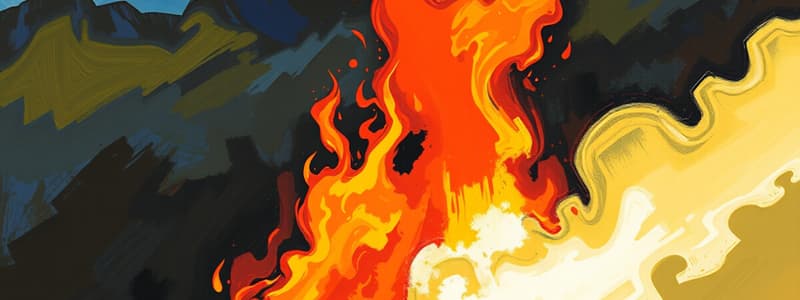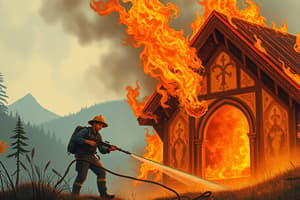Podcast
Questions and Answers
Which factor does NOT affect the behavior of a wildland fire?
Which factor does NOT affect the behavior of a wildland fire?
- Fire management techniques (correct)
- Topography
- Humidity levels
- Weather conditions
What happens to fire spread during the late afternoon as humidity decreases?
What happens to fire spread during the late afternoon as humidity decreases?
- Fire spread slows down considerably
- Fire spread becomes erratic
- Fire spread remains constant
- Fire spread increases significantly (correct)
When does the local wind typically shift from East to West to West to East?
When does the local wind typically shift from East to West to West to East?
- In the morning hours
- At midday (correct)
- In the evening
- During the night
What is indicated by a Red Flag Warning issued by the National Weather Service?
What is indicated by a Red Flag Warning issued by the National Weather Service?
How does a slight decrease in relative humidity affect fire intensity?
How does a slight decrease in relative humidity affect fire intensity?
What is the primary impact of increased humidity on fire behavior in the evening?
What is the primary impact of increased humidity on fire behavior in the evening?
What effect does hot and dry weather have on fire spread?
What effect does hot and dry weather have on fire spread?
During a typical day, what directional change occurs to local winds at midday?
During a typical day, what directional change occurs to local winds at midday?
Which factor contributes to creating dangerous convection currents in large wildland fires?
Which factor contributes to creating dangerous convection currents in large wildland fires?
What critical change can occur to surface-wetted fuel under extreme conditions?
What critical change can occur to surface-wetted fuel under extreme conditions?
Flashcards are hidden until you start studying
Study Notes
Fire Behavior Influencing Factors
- Critical factors affecting wildland fire behavior: Weather, Fuel, and Topography.
- Command must maintain constant awareness of these factors to react promptly and proactively.
Weather Conditions
- Weather conditions are dynamic and can change rapidly, particularly winds.
- Local winds typically shift 180 degrees from morning (East to West) to afternoon (West to East).
- Fire spread slows in the evening due to increased humidity (approximately 25%).
- Fire spread intensifies during mid-morning when humidity levels decrease (about 15%).
- A Red Flag Warning from the National Weather Service indicates critical conditions for brush/wildland fires.
- Special caution required for fire incidents during a Red Flag Warning.
Convection Currents and Wind Effects
- Large wildland fires can create dangerous convection currents leading to unpredictable fire behavior.
- Spot fires may ignite far ahead of the main fire front due to these currents.
- Heavy winds exacerbate erratic fire behaviors, increasing both spread and intensity.
Fuel Conditions
- Hot, dry weather accelerates fire spread significantly.
- Just a slight drop in relative humidity can lead to a notable increase in fire intensity.
- Surface-wetted fuels can dry within minutes on extremely hot days, increasing fire risks.
Fire Behavior Influencing Factors
- Critical factors affecting wildland fire behavior: Weather, Fuel, and Topography.
- Command must maintain constant awareness of these factors to react promptly and proactively.
Weather Conditions
- Weather conditions are dynamic and can change rapidly, particularly winds.
- Local winds typically shift 180 degrees from morning (East to West) to afternoon (West to East).
- Fire spread slows in the evening due to increased humidity (approximately 25%).
- Fire spread intensifies during mid-morning when humidity levels decrease (about 15%).
- A Red Flag Warning from the National Weather Service indicates critical conditions for brush/wildland fires.
- Special caution required for fire incidents during a Red Flag Warning.
Convection Currents and Wind Effects
- Large wildland fires can create dangerous convection currents leading to unpredictable fire behavior.
- Spot fires may ignite far ahead of the main fire front due to these currents.
- Heavy winds exacerbate erratic fire behaviors, increasing both spread and intensity.
Fuel Conditions
- Hot, dry weather accelerates fire spread significantly.
- Just a slight drop in relative humidity can lead to a notable increase in fire intensity.
- Surface-wetted fuels can dry within minutes on extremely hot days, increasing fire risks.
Studying That Suits You
Use AI to generate personalized quizzes and flashcards to suit your learning preferences.



